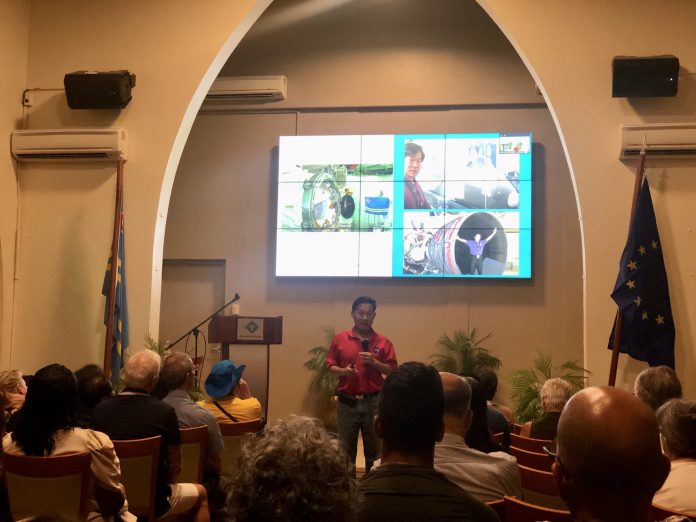On Thursday, the 23rd of February, Dr. Edward Cheung gave a lecture titled “An evening in Space: The Story of an Aruban Engineer at NASA” at the University of Aruba. In this lecture, Dr. Cheung shared his life story and experience at NASA, as well as answered some burning questions about space technology and his hopes for the future of the space institution.
The evening started with a small introduction from University director Prof. dr. Viola Heutger, in which she expressed her gratitude for Dr. Cheung’s presence. Additionally, she expressed her pride in being able to host someone that has direct knowledge and experience with one of the world’s most famous organization for space exploration. Prof. dr. Heutger ended her introduction with a thanks to the audience as she passed the mic to Dr. Cheung.
Dr. Cheung’s higher academic career started in Aruba, where he attended Colegio Arubano secondary school at both San Nicolas and Oranjestad. After receiving his high school diploma, he continued his studies at Worcester Polytechnic Institute in Worcester, Massachusetts and Yale University in Connecticut, which he studied electrical engineering at both.
Since childhood, Edward expressed a passion for engineering; he shared with the public a childhood memory in which he remembered being fascinated by the mechanisms of his radio and the possibilities this piece of technology had. For him, it was “magic”. From that day onward, he developed a passion for engineering and tinkering. Currently, Dr. Cheung is based at Goddard Space Flight Center in Maryland. He has been working for NASA for 32 years, in which he led and participated in various projects, including the famous Hubble Telescope.
During his lecture, Dr. Cheung of course mentioned his viral video of him floating in zero gravity, during which he opened the Aruban flag. This was a huge moment for the island, as this is the first time that our home country was being represented in such an extraordinary circumstance. Dr. Cheung expressed that he did not think that the video would become a hit, but he was evidently proven wrong.
He also shared his plan to bring white sand from Aruba to the moon. This idea came about after watching several documentaries on the moon landing in 1969. He realized that the astronauts were able to leave some of their belongings on the moon. This inspired the doctor, because he thought what a great privilege it would be to be one of the few on the planet to have something on the moon. He decided he wanted to bring some of the white sand of Aruba’s beaches to the moon, as this is something that the Aruban community shares collectively. He also mentioned that it was important for him to be able to vocalize his reason for this, for which he said: “To show that the reach of someone on this island goes beyond this world.”
Coincidentally, Dr. Cheung is a part of a new NASA program in which they will be making a commercial flight back to the moon. The doctor was one of the few experts assigned to advise some groups of organizations and institutions before their trip. Because of this, he thought what better time to take the sand to the moon. Dr. Cheung expressed that the project is due this March.
During his lecture, Dr. Cheung also answered some questions covering different topics about NASA’s methods, technology and even aspirations. He shared with the audience his experience with the Hubble Telescope. For this project, the doctor expressed that he wanted to further promote Aruba at NASA. To do this, he named the relay machine that his team was building “ARUBA”. However, in order to get the name for his “ARUBA box” approved by his superiors, he needed to make it an abbreviation for a much longer name, so he concluded that “ARUBA” stands for “ASCS/NCS Relay Unit Breaker Assembly.” This way, he managed to get the name approved.
The lecture was a highly interactive one, where the audience enthusiastically asked the doctor many questions about a range of topics, including on the mechanisms of the James Webb Telescope, from which NASA recently shared extraordinary pictures of the far galaxy. He also covered topics such as sustainability within NASA projects, as well as his and NASA’s future goals for space exploration.
Dr. Cheung ended his lecture with an advice for the youths of Aruba, in which he pointed out that he came to be where he is now because of his hard work and curiosity. So, he advises the youth to do the same, to keep doing self-study and keep being a “tinkerer.” Finally, he also expressed that NASA’s future is “bright”, and he hopes for bigger telescopes for further exploration of our universe.




















